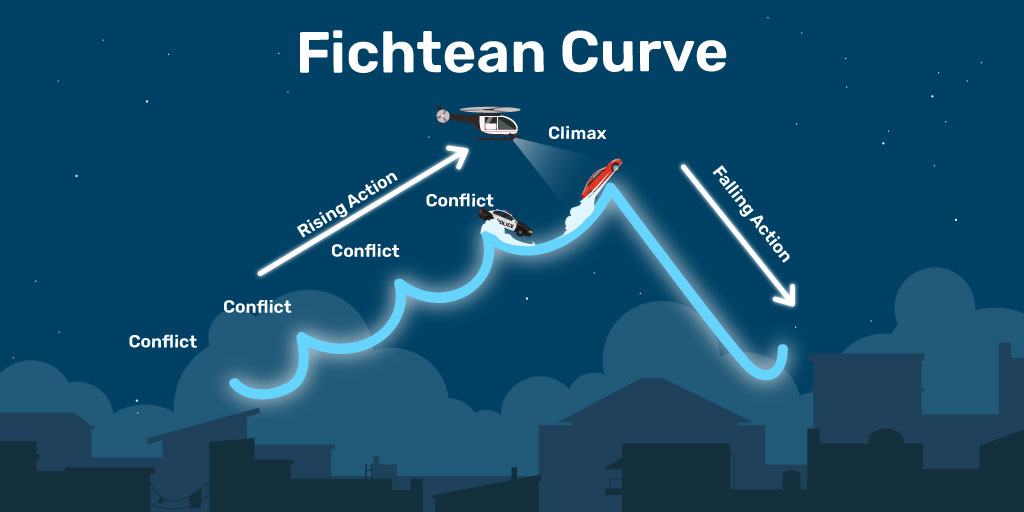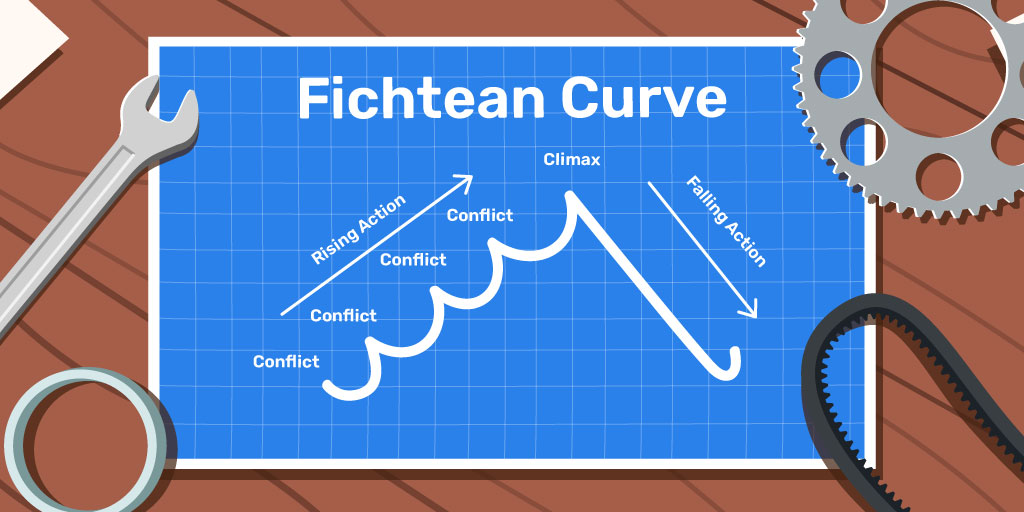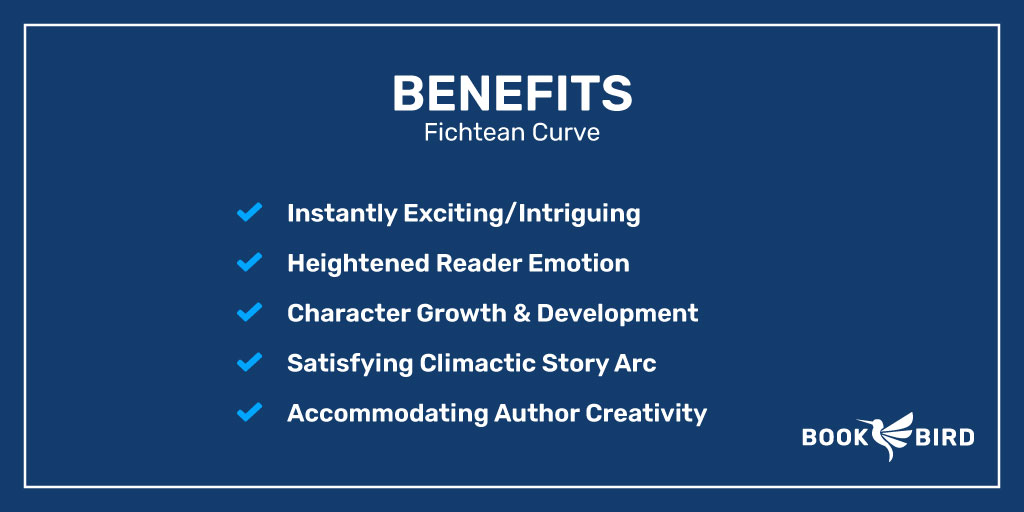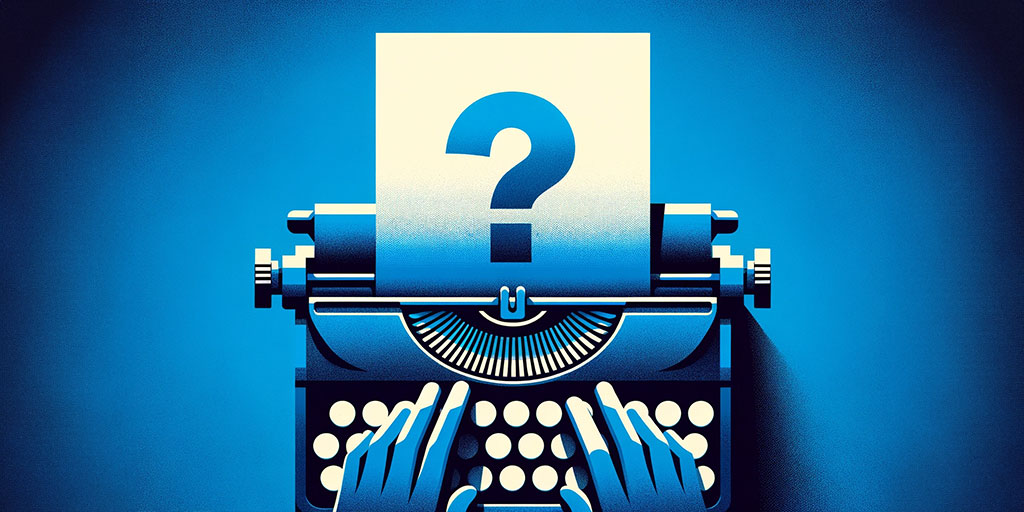Picture this: a heart-pounding incident that lures you into a fictional realm, a rollercoaster of rising tensions that sweeps you off your feet, a thrilling climax that takes your breath away, and a satisfying resolution. This is the essence of the Fichtean Curve story structure—a narrative archetype that has captivated audiences from ancient civilizations to the digital age.
In this guide, we will explore the elements that make the Fichtean Curve structure so exciting, the building blocks that constitute its exhilarating arcs and turning points, and the principles that make it such a powerful tool in the hands of storytellers in most genres.
What is the Fichtean Curve?

The Fichtean Curve story structure is a compelling narrative technique that revolves around three key stages: rising action, climax, and falling action. It follows a gradual progression of tension and emotion, leading the audience on an emotional journey that reaches its peak at the climax, about 70 percent through the story.
Because it immediately builds tension with an inciting incident within the first few pages, it allows writers to pique their readers’ curiosity right from the beginning. Introducing the main characters and their central conflicts at the start creates a strong emotional connection between readers and the story.
Fichtean Curve vs Traditional Story Structures

Compared to traditional story structures, the Fichtean Curve offers a different approach to pacing and tension-building.
Almost all techniques for outlining stories, including the Hero’s Journey, the Three-Act Structure, Freytag’s Pyramid, and the Five-Act Structure, start with a slow introduction of the characters and setting. It is only after the central players have been introduced that the inciting incident takes place that sets the story in motion.
The Fichtean Curve, on the other hand, dives straight into the action with the inciting incident on the first few pages. This moment marks the beginning of the first crisis that the characters face. And once the story is in motion, the tension never stops, as this structure drives it forward through a series of crises. Accordingly, the settings and characters are introduced as the crises intensify, not before they begin.
With the exception of the Three-Act Structure, the Fichtean Curve is also simpler. It does not prescribe five (Freytag’s Pyramid), seven (Seven-Point Structure), 12 (Hero’s Journey), or 15 (Save the Cat Beat Sheet) stages through which writers should outline a story. There are only three prescribed stages, with the first broken down into as many crises as the author needs.
Who Invented the Fichtean Curve?
The term “Fichtean Curve” was first coined by author, literary critic, and college professor John Gardner in his book “The Art of Fiction.” He noticed that many memorable stories contained the three stages of rising action, climax, and falling action. Consequently, he formulated a story structure based on them to guide new writers to write good stories.
Gardner attributed the structure to German philosopher Johann Gottlieb Fichte, which mystified Fichtean scholars due to the absence of anything similar in Fichte’s own work. But whatever the reason for the name, Gardner devised the system based on his research of unforgettable stories.
Craft of Writing Quiz (Easy)

3 Stages of the Fichtean Curve

The Fichtean Curve is split into three parts:
Let’s examine these stages and their unique roles in a story.
1. Rising Action
Rather than starting with an extended introduction that meticulously sets up the main character and their environment, the Fichtean Curve suggests that authors should plunge into the unfolding drama immediately and set the wheels of the narrative in motion without delay.
Accordingly, your story starts with the inciting event, which constitutes the first crisis for your important characters. This serves as a catalyst that propels them from their familiar surroundings into their new adventure.
The rising action then proceeds through an escalating sequence of crises, each posing a more demanding challenge and test of your characters’ resources. The bulk of your tale, approximately two-thirds to 70 percent, should consist of this series of intensifying predicaments. Think of each crisis as a big event that propels the story forward, a significant incident that directly leads to future crises and the climax.
Essential background information should be delicately intertwined with this unfolding drama as the storyline advances, without ever stopping the story from moving forward. Your characters’ personalities, backgrounds, flaws, motivations, and unique mannerisms should emerge naturally as they respond to their challenges.
Because it dives directly into the first crisis, the first role of the rising action is to capture readers’ attention quickly and to immerse them in the story’s central conflict.
By intensifying tension through a series of crises, its second role is to keep them invested in the characters’ challenges and to make them eagerly anticipate the climax.
Given that around 70 percent of your novel consists of the rising action, it is a crucial segment of your story to do well. This section should capture readers’ attention and make them want to continue reading.
2. Climax
The climax stage is the emotional and narrative apex of the story, where the tension reaches its peak and the central conflicts come to a head.
It is characterized by decisive actions and confrontations. The characters are faced with crucial choices that have critical consequences. Conflicts between characters or their internal struggles, called external and internal conflicts, reach their final stand. These intense emotional encounters propel them to success or failure, depending on the story you’re writing.
During the climax, important revelations and truths can be unveiled. Secrets can be exposed, hidden motives can be brought to light, and characters’ pasts may haunt them. These revelations add depth and complexity to the narrative.
The characters face their most significant challenges, forcing them to confront their flaws, fears, and desires. This moment of truth often leads to profound character transformations and growth.
The role of the climax is to provide an emotional peak that thrills and moves the readers. If you fail to move their emotions, your climax will become an anti-climax and fall flat for your readers.
3. Falling Action
The falling action follows the climax and serves as the narrative’s resolution and emotional release phase. It depicts the immediate aftermath of the intense events during the climax. There might still be a bit of action here, but it should be dwindling toward the end of the story.
Some conflict may also persist into this stage, but this is when the remaining conflicts and subplots should be resolved, and both the characters and your readers should reach a state of closure.
This stage can include the characters’ emotional responses to the climax, typically relief, joy, grief, or a mix of emotions. Characters may also reflect on their experiences and the lessons learned from the challenges they faced. This introspection allows for further character growth and development.
Or it might explore the impact of the climax on the relationships between characters, showing how their bonds have been strengthened or strained by the events of the story.
The role of the falling action is to provide closure to the story’s central conflicts, offering readers a sense of satisfaction and completion. It should also reinforce the themes and messages conveyed in the narrative, offering insights into the story’s broader significance.
Examples of the Fichtean Curve
The Fichtean Curve has been successfully used to create some of the most memorable stories across many centuries. We will consider two examples below.
In each example, we will include the consequences of some crises, without which a story description won’t make sense. Often, each crisis has consequences that lead to the next big crisis.
“The Hunt for Red October” by Tom Clancy
Ranked by PBS in the top 100 most-loved books in the US, “The Hunt for Red October” follows the thrilling Cold War era tale of a defecting Soviet submarine captain, Marko Ramius, who seeks asylum in the United States aboard his highly advanced nuclear submarine. CIA analyst Jack Ryan must decipher Ramius’ true intentions to determine whether and how the submarine should be captured without causing a serious international incident.
Rising Action – Crisis 1
Before setting sail, Soviet Navy commander of the submarine Red October, Marko Ramius, sends a message to his superiors on land stating his intention to defect to the United States. He immediately kills his onboard political officer to prevent him from interfering.
The immediate consequence of this crisis is that the Soviets dispatch their navy to go and sink Red October since it contains a stealth drive system they don’t want to be leaked.
Rising Action – Crisis 2
CIA analyst Jack Ryan hypothesizes that Red October has a stealth drive system, and after putting together many available pieces of information, he works out that Commander Ramius wants to defect.
The direct result of this work is that the American and British navies send ships to the submarine’s route to be on standby. However, the US president states it won’t be possible to capture and keep it without causing a huge international incident unless they could do it secretly by, for example, getting all the non-defecting seamen off it first.
Rising Action – Crisis 3
Ryan and his colleagues board Red October, pretending that they are rescuing the crew from a reactor failure. The non-defecting crew leaves, and the US Navy blows up one of their own decommissioned submarines to convince the Soviets the Red October has exploded.
As a result, the Soviets recall their navy from the area.
Rising Action – Crisis 4
One non-defecting Soviet intelligence officer manages to stay on Red October and tries to blow it up.
He kills one defecting officer and wounds Ramius, but Ryan kills him.
Climax
While two US submarines escort Red October to the American coast, a Soviet submarine recognizes it and starts firing at it. Ramius rams the attacking ship and sinks it by ramming it.
Falling Action
The Americans complete their secret capture of Red October by guiding it into a naval dock. Ramius receives a new identity and permission to remain in the US. Ryan is praised for a successful operation.
“Phantoms” by Dean Koontz
In one of Dean Koontz’s most popular horror novels, “Phantoms,” a small town is mysteriously wiped out, with everyone either dead or gone. Those who are called in to help, who are killed in large numbers too, discover that the town is built on top of the lair of a shape-shifting creature that occasionally feeds.
Rising Action – Crisis 1
Sisters Jenny and Lisa return to Jenny’s home in Snowfield, just to find that all inhabitants of the town are either dead, mutilated, or gone.
As a part of whatever happened, strange voices are audible over the phone, and the church bells and firehouse siren ring automatically. They call the neighboring town’s police to come and help.
Rising Action – Crisis 2 (Subplot)
In the neighboring town, Sheriff Bryce Hammond locks up a psychopath called Fletcher Kale, who killed his wife and young son.
Later in the novel, Kale escapes and hides in a cave beneath Snowfield.
Rising Action – Crisis 3
After the police arrive, led by Sheriff Hammond, two of the officers are soon killed by something the survivors know they have never seen before—a moth-like creature that removes one of the officers’ brains and drains all of his blood.
In response to this event and voices continuing to come from the phones and the drains, the officers start to suspect that the enemy might not be natural.
Rising Action – Crisis 4
The police find one clue to the predator’s identity—the name “Timothy Flyte” written on a mirror by a hotel guest.
Through phone calls with the acquaintances of the guest, they discover that Timothy Flyte is a scientist who has written books on mass disappearances carried out by creatures he calls “The ancient enemy.” A publisher gets hold of Flyte and puts him on a plane to the United States.
Rising Action – Crisis 5
After the scientists from a military Chemical and Biological Weapons Unit arrive to look around and collect tissue and water samples, all but one of them are killed by things that look like animals or blobs of slime.
Rising Action – Crisis 6
After Flyte arrives in Snowfield, the survivors talk to the predator through the scientists’ computer. When the predator leaves them a tissue sample to show off, the one remaining scientist manages to identify it as similar to fossil fuel.
By pretending to the predator that she needs materials to investigate it further, she sends a message to fellow scientists to send a compound made of oil-eating bacteria.
Climax
When the spray bottles with the compound arrive, the six survivors gather around the drains to spray it on the predator’s main body beneath the town. After a deadly confrontation, four survivors manage to kill it.
Falling Action
While the injured survivors recover in hospital, murderer Fletcher Kale and a biker friend unsuccessfully attack them, and he is shot dead. Sheriff Hammond and Jenny get married.
How to Use the Fichtean Curve

Since the Fichtean Curve structure gives fairly little advice beyond the three stages, let’s have a detailed look at some of the strategies writers can employ to make it most effective.
1. Start with an Intriguing Crisis
Begin your story with a fascinating crisis or conflict that immediately engages readers and propels them into the heart of the action. This incident should be interesting enough to capture your readers’ attention immediately and completely. Dump your main character in as much turmoil as you can.
Consider the following examples:
- The protagonist wakes up in an unfamiliar location, without memory of how they got there, and discovers a ticking bomb nearby.
- An astronaut on a solo mission to Mars encounters a mysterious anomaly that damages their spacecraft, leaving them stranded on the barren planet.
- A successful lawyer’s former client resurfaces, accusing them of misconduct, risking their reputation and career.
- A woman arrives at her wedding to a man about whom she feels lukewarm, just to find that her high school first love, who dumped her for another girl, is waiting for her at the altar.
2. Tell Stories in Any Genre
Because of its emphasis on crises and conflict, the Fichtean Curve is especially popular in genres like horror, thriller, mystery, action/adventure, and science fiction. But there is no reason why it cannot be used in other genres too.
The crises during the rising action do not have to be life-or-death challenges, like in the abovementioned genres. Something like an argument or embarrassing event is also a crisis.
Consider how crises operate in different genres, and note the presence of both external and internal crises on this list of examples:
- Thriller: A threat to the protagonist’s life, a kidnapping, a narrow escape from danger, discovering a sinister plot, or being framed for a crime they didn’t commit.
- Mystery: Discovering a crucial piece of evidence that changes the direction of the investigation, encountering a red herring that throws off the sleuth, or being blackmailed or threatened by the antagonist.
- Science Fiction Novel: Uncovering a conspiracy or government concealment, encountering a hostile alien, dealing with the ethical implications of advanced technology, or facing a moral dilemma about the use of a futuristic innovation.
- Fantasy/Adventure: Embarking on a dangerous quest, encountering a mythical creature, or a betrayal among the protagonist’s allies.
- Horror: Encountering a terrifying entity or supernatural occurrence, being trapped in a haunted location, or questioning one’s sanity due to strange occurrences.
- Romance: An argument or misunderstanding between the main characters, a past trauma resurfacing to create tension, a rival love interest entering the scene, or facing conflicting feelings and societal expectations.
- Drama/Contemporary Fiction: A family secret, a career setback, a betrayal by a close friend, a financial problem, or a health issue that challenges the protagonist’s resilience.
- Historical Fiction: A political upheaval or war threatening the characters’ safety, a social norm or cultural barrier creating tension or angst, or navigating the challenges of a primitive setting like a lack of communication or transport.
3. Develop Relatable Characters
Create well-rounded characters with distinct goals, motivations, and flaws, which is, of course, something you should do when writing any story. But because your Fichtean Curve planning will throw you straight into the action and keep your focus there, it is possible to overlook dedicated character development.
The truth is that characters develop really well through crises and conflicts. All you need to do is to allow them to face challenges that contribute to their growth throughout the narrative.
Consider the following example: In the aftermath of a natural disaster, a timid and anxious young person must navigate the chaos and destruction to find and rescue their missing family.
Think about how they change from the first obstacle to the second, third, and fourth. Answer the following questions about their journey:
- What drives them to continue their quest?
- Do the factors that drive them stay the same or change?
- Which skills do they learn?
- What vulnerabilities do they have?
- Are vulnerabilities strengthened or weakened through their struggles?
- What backstories and traumas have made them what they are?
- Do their backstories help or hinder their progress?
- What do they do when they fail and succeed in a crisis?
- What do they say to themselves during difficult situations?
- What relationships do they have?
- How are their relationships affected by their difficulties and the changes in them?
- How do they feel throughout their journey?
By weaving these elements together, you can develop relatable characters who captivate readers as they navigate their crises. The journey of overcoming challenges and growing emotionally resonates with readers, forging a strong bond between them and the characters.
4. Pick an Exhilarating Climax
Build up to the climax by carefully pacing the story, allowing tension to peak at just the right moment for maximum impact. While your main character will go through many crises, none of them should overshadow the climax, which should be the toughest challenge in the story.
Your readers will experience an emotional letdown if the exciting crises fizzle out in a dull or no climax.
The best way to do this is to increase the stakes for your character throughout the rising action crises. If the consequences of failure are worse for the climax than for any individual crisis, the former will automatically have an edge.
Employ vivid and immersive descriptions to clearly depict the climax’s setting, action, and emotions. This will heighten the readers’ engagement with the scene.
5. Pace the Falling Action Correctly
Avoid rushing or dragging out the falling action. Resolve the major conflicts and storylines introduced in the rising action and climax without over-explaining or starting a new story.
Even though the climax is over, keep the falling action interesting by including smaller obstacles for the characters to overcome on their way to the story’s resolution. This will maintain reader engagement up to the end.
Be critical of each scene’s contribution to the story’s resolution. If a scene doesn’t add significant value, consider cutting it to keep the pace flowing.
Pros and Cons of the Fichtean Curve
Let’s now delve into the benefits and drawbacks of the Fichtean Curve, uncovering its power to captivate readers and the potential challenges it presents to writers.
Benefits of the Fichtean Curve

From the gradual heightening of tension to the growth of characters, there are many reasons why the Fichtean Curve is a great way to enthrall readers. Here are some of its strengths:
- Instantly Exciting/Intriguing: Because this storytelling curve starts with the first crisis, readers are immediately in the middle of the action, establishing instant excitement or intrigue.
- Heightened Reader Emotion: By strategically placing crises and turning points, the Fichtean Curve elicits powerful emotional responses from readers, intensifying their connection to the characters and the story and making it difficult to put down the book.
- Character Growth and Development: The structure’s emphasis on crises and challenges provides ample opportunities for character growth and transformation, allowing authors to craft multidimensional and relatable protagonists.
- Satisfying Climactic Story Arc: The Fichtean Curve culminates in a climactic peak, satisfying readers’ thirst for action, excitement, and drama.
- Effective Storytelling Tool: As a versatile storytelling tool, it can be applied to most genres and themes.
- Accommodating Author Creativity: Because it contains only three stages with increasingly intense crises, it allows for plenty of author ingenuity and vision that more comprehensive story structures stifle.
Drawbacks of the Fichtean Curve

While the Fichtean Curve story structure offers numerous benefits, it also presents some drawbacks for authors to consider:
- Restrictive Structure: Strictly adhering to the Fichtean Curve may limit creative freedom for authors who prefer more experimental or non-linear storytelling approaches, such as relying on letters/diaries or including different timelines.
- Risk of Formulaic Writing: Relying heavily on the crisis curve without adding unique elements (like subplots) can result in formulaic writing, potentially making the narrative feel clichéd or lacking originality.
- Action Dominating Characters: The structure’s emphasis on plot progression may require authors to carefully balance character development, as the plot can potentially overshadow deep and intricate character arcs.
- Limited Exploration of Subplots: The emphasis on the central conflict might limit the exploration of intriguing subplots that could enrich the story and characters.
- Tension Maintenance Challenge: Sustaining rising tension throughout the narrative can be challenging for some authors, as the story’s intensity must escalate steadily to create a compelling climax.
- Challenges Multiple Perspectives: If multiple characters confront completely different conflicts in a story, it might be difficult to manage a coherent rising action and climax for each.
Frequently Asked Questions
In this section, we will answer some short questions that authors often ask about the Fichtean Curve story structure.
What is the Main Goal of the Fichtean Curve?
The main goal of the Fichtean Curve is to provide a structured story that captures readers’ attention and leads to their emotional immersion in the characters’ struggles, growth, and triumphs throughout the narrative.
Can the Fichtean Curve Be Used for Any Genre?
Yes. The Fichtean Curve can be used for any genre of storytelling. Its flexibility and universal appeal make it applicable to various genres, including adventure, mystery, science fiction, romance, fantasy, thriller, drama, historical fiction, horror, and comedy.
Can I Use Multiple Fichtean Curves in a Single Story?
Yes, you can use multiple Fichtean Curves in a single story, especially in complex and multi-layered narratives. Incorporating multiple Fichtean Curves allows you to structure different plotlines or character arcs, creating a more intricate and engaging storytelling experience. This approach is commonly seen in stories that involve multiple protagonists, parallel storylines, or significant subplots.
What Are Common Mistakes When Using the Fichtean Curve?
Common mistakes when using the Fichtean Curve include forcing the structure, neglecting character development, and under-developing the climax. Authors should avoid rigid adherence to the curve, focus on well-rounded characters, and write an exhilarating climax.
Who is Johann Gottlieb Fichte?
Johann Gottlieb Fichte (1762-1814) was a German philosopher who played a significant role in the development of transcendental idealism, significantly building on the work of Emanuel Kant. He is known for his contributions to philosophy of science, epistemology, consciousness, ethics, law, political philosophy, and philosophy of religion.
Final Thoughts
Through its strategic placement of crises and climaxes, the Fichtean Curve draws audiences into a rollercoaster of emotions, fostering deep connections with characters and their transformative journeys. While embracing the structure’s benefits, you should exercise creativity in adapting it to suit your unique stories and storytelling styles. Harnessing its potential has enabled many writers to weave tales that have left a lasting impact on their readers.
Craft of Writing Quiz (Hard)








